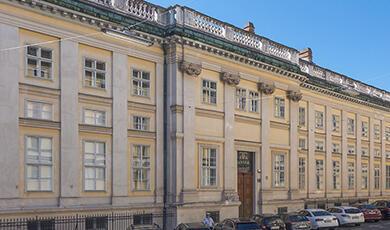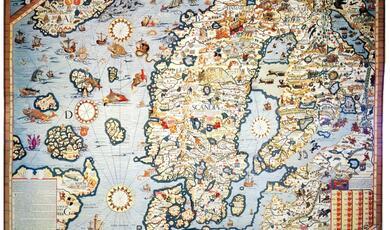Music and nationhood
Share
- Details
- Text
- Audio
- Downloads
- Extra Reading
Download Text
Music and nationhood
Professor Adrian Thomas
Background
Today is by way of a prelude and many of its issues will, I hope, resonate in subsequent lectures in this series. I've a particular interest in the music of Poland and in the arts and culture of Central Europe. When devising this series I was keen to explore aspects of Central European music which are different to those with which we're familiar or which haven't always been part of our 'Western' European or British experience. An early question is: what do we call this region? What is meant by 'Central Europe'. Would the term 'Eastern Europe', familiar from the post-war decades, be any better? For today's lecture on early 20th-century music, I've plumped for 'East-Central Europe'.
An upshot of this debate is how a consideration of the turbulent history of this variously defined region affects our understanding of its music and culture at different times over the centuries. Our general appreciation of this wide geographical area tends to focus on mainstream 19th-century figures - like Chopin, Liszt and Dvorak - as well as on a few 20th-century composers such as Janacek, Bartok and, to a lesser extent, Szymanowski. Today, I'll be looking primarily at the music of these last three composers - plus a few others, because it's important to make at least small inroads into the misleading human tendency to build national edifices on a few iconic figures. But let's return to the matter of familiarisation with 'Central Europe' and its terminological variants.
First, two examples of non-musical definitions.
[Fig.1: Map of Central Europe (Partsch, 1903/05)]
The first is a map from a book entitled 'Central Europe', written exactly 100 years ago. Its author, Joseph Partsch, was Professor of Geography at the University of Breslau, then part of Germany, now part of Poland and known today as Wroclaw. As far as Partsch was concerned, Central Europe - mainly comprising Germany and the Austro-Hungarian Empire - stretched from the borders with Russia and the Turkish (Ottoman) Empire, in the south-east (both borders being much further west as you can see than they are today), to the North Sea shores of Belgium and the Netherlands. A bit too broad, we might think.
As a second example, we might look at the developing membership over the last ten years of the annual Central European summit of heads of state.
[Fig.2: Central European summit, 1993]
In 1993, the summit was attended by the Presidents of Austria, a newly reunited Germany, Hungary and the Czech Republic. And that grouping - with countries from both sides of the post-war East-West divide - pretty much accords with the idea of a Central Europe based on the territories of the old German and Austro-Hungarian Empires, even if reduced in scale.
[Fig.3: Central European summit, 2001]
But, by 2001, this quartet of countries had expanded to fourteen, with additional attendance by the presidents not only of former Soviet-bloc countries Bulgaria, Romania, the Slovak Republic and Poland, but also of former USSR territories (Moldova and Ukraine, but not Bielorus or the Baltic States) and, to the south, of Slovenia, Croatia, the Federal Republic of Yugoslavia and, interestingly, of Italy! Now, that is some 'Central Europe'!
In between these two temporal extremes, 1903 and 2003, there have been, as we know all too well, drastic and violent upheavals across Europe, as these further two maps reveal:
[Fig.4: Map of Europe, 1923]
After the Great War (1914-18), the map of much of Central Europe was redrawn. The drive towards individual nation-states was at its height as countries, hitherto partitioned and absorbed under German, Austro-Hungarian or Russian rule, were separated out again.s
[Fig.5: Map of Europe, 1953]
After World War Two (1939-45), borders were changed once more, but for different reasons. Poland's borders, for example, shifted westwards. Its eastern third reverted to Ukraine and direct Soviet control; much of its Polish population was relocated across central Poland to a new western third, the formerly German-speaking 'Regained Territories', which included Breslau, aka Wroclaw. By the end of the 1940s, however, the political, military and financial significance of individual national borders was overshadowed by Churchill's symbol of the 'iron curtain' and the onset of the Cold War between the 'capitalist', 'imperialist' West and Stalin's USSR and its bloc of satellite socialist republics.
And so things basically remained until the upheavals of the 1980s, symbolically anticipated by the election of the Polish Pope 25 years ago. These upheavals began in earnest with the formation of the Polish free trade union 'Solidarity', through Gorbachev's perestroika in the Soviet Union and culminating in revolutions, velvet as well as violent, elsewhere in the region. And now - who'd have believed it even fifteen years ago - countries from the eastern side of the 'iron curtain' have joined NATO and are on the verge of becoming members of the European Union.
Introduction
This rapid overview, simplified though it is, does bring to the fore the problems of defining nationhood in the 20th century. How, then, may we place culture and the arts, and more particularly music, in these shifting frameworks? In forthcoming lectures, I'll be looking in detail at the function of music since 1945 in three countries in East-Central Europe: the lands of what were until recently the Communist or People's Republics of Czechoslovakia, Hungary and Poland.
[Fig.6: Map of Europe, 1903]
These lectures will look at music and propaganda in the post-war decade, at new music in the specifically Hungarian context (with guest speaker Dr Rachel Beckles Willson), at the role of the media, at the musical ramifications of war and peace, and at the place of sacred music in communist and post-communist society. Today, though, a few thoughts on the place of music and its composers in the first few decades of the 20th century.
Let's hold such cartographical images in mind while we turn to consider the central theme of music and nationhood. Or should that be nationality or nationalism? A recent and useful maxim has it that 'Nationality is a condition; nationalism is an attitude' [1]. We might say, nationality as a factual given, nationalism as a state of mind or activity. This maxim is, however, subject to qualification, if only because the individual life-spans of both composers and listeners, especially in the 20th-century, intersected historical events that inevitably questioned the nature and viability of such definitions. How, for example, does it deal with issues of exile or emigration? Where does it place composers as varied in their life-experience as Chopin (1810-1849), who was part of the 'Great Emigration' from Poland to France in the revolutionary 1830s, or the Czech composer Bohuslav Martinu (1890-1959) who went to Paris in the 1920s and on to America in 1940, or Gyorgy Ligeti (b.1923), the Hungarian composer who was one of thousands who fled westwards in the wake of the failed Hungarian Uprising against Soviet oppression in 1956?
'Nationhood', as distinct from nationality or nationalism, might be regarded as coterminous with historical events in so far as it implies shared experience and responsibility on a broad scale. It certainly suggests complementary avenues of enquiry into the relationship between the individual and the nation. Today, we're arguably less exercised by issues of music and nationality, nationalism or nationhood than our forbears in the 19th and 20th centuries. There's now far greater interest in multiculturality within states than in cultural differences or similarities between them. A more radical view is that: "We are all individual music cultures ... a fascinating counterpoint of near and far, large and small, neighbourhood and national..." [2] That makes it even more intriguing to see how nationality, nationalism and nationhood were embodied in earlier periods, how individual composers responded to changing situations, and how, if at all, their music became definitive or symbolic of a time, place or circumstance.
Overt or subtle reference to one's own national traditions, often folk dances - polonaise, mazurka, furiant, dumka, czardas, or verbunkos - was a commonplace feature of how 'popular' idioms were appropriated and adapted into art music in the 19th century. It was part of the surging drive to define nationality at a time when the big three empires pursued their aims by containment or suppression of national aspirations through culture. I hope to be looking the development of 19th-century music and musical life in a future series of Gresham lectures. For now, I'll dip into the early 20th-century in four selected areas: (i) music and landscape, (ii) music and politics, (iii) music and exoticism, and (iv) music and abstraction.
Music and Landscape
We're all familiar, I'm sure, with the nationhood being equated with the shared experience of cultural traditions. But let's not forget that there are many layers of knowledge: commonality of experience, even within one nation, is often virtual rather than real. A Moravian wouldn't necessarily identify with a Bohemian, or a Mazovian with a Krakowiak. And yet folk traditions - given centuries of migration across Europe - often exhibit common features across so-called national boundaries. Let's take a geographical example once again. The Tatra Mountains, part of that almost unbroken range that stretches from Spain's Atlantic coast to the Bosphorus, form the border between Poland and Slovakia. Depending on your perspective, the same mountain has many different profiles, from either the Polish or Slovakian angle, or both. Similarities and differences are a matter of time as well as place.
The Tatra Album for piano (1884) by the Polish composer and pianist Ignacy Jan Paderewski (1860-1941) is a youthful, rather dainty musical evocation of the Tatras' significant culture and folk tunes. Almost 50 years later, Karol Szymanowski (1882-1937) composed a choral-orchestral ballet Harnasie (1931) which is a full-colour, full-throttle evocation of a disrupted highland wedding. Its genuine and mock folk material are intertwined in a manner which, even today, smacks of the authentic rather than the picturesque. Both works use actual folk melodies to authenticate their national credentials. A musical landscape becomes patriotic.
There's another type of landscape, one less transparently wedded to local musical culture: the landscape of the spirit, both national and individual. Without getting too enmeshed in 19th century philosophies of human struggle and transcendence, there's no doubt that the use of landscape as metaphysical inspiration was still highly potent in the early 1900s. Let's take two near-contemporary composers whose names are still quite unfamiliar: the Czech Vitezlav Novak (1870-1949), who was a pupil of Dvorak in Prague, and the Mieczyslaw Karlowicz (1876-1909), who studied in Berlin. Novak came from Bohemia, but found interest in Moravia and Slovakia south of the Tatras, Karlowicz - part Lithuanian, part Polish - came from the northern side of the range. Each, in his different way, was influenced by these mountains, taking them as symbols of a higher plane of meaning than mere rock and ice.
Novak's symphonic poem In the Tatras (1902) is in many ways traditional, in both language and programmatic underlay, but it also takes the listener into trans-national philosophical realms suggested by Nietzsche and Schopenhauer. The mountains, with "the luminous air of the peaks and the primitive horror of the abyss, chasms, plunging cascades and gloomy forests" [3], become quasi-religious symbols of man's existential travails, yet they retain and impart a transcendental nobility.
Ex.1 NOVAK In the Tatras
0'00 - 2'00"
Although Karlowicz never wrote anything programmatically connected with the Tatra mountains, they were his lifeblood. He climbed their most dangerous peaks, was a noted photographer of their angular majesty, and, at the cruelly early age of 32, he was killed there by an avalanche. He once wrote:
" And when I find myself alone on a precipitous summit, having only the azure cupola of the heavens above, and below and around me frozen waves of peaks sinking into the sea of the plains - then I begin to dissolve into the surrounding spaces, I cease to feel like a separate individual, and am covered by the powerful, everlasting breath of eternity. This breath runs through all the fibres of my soul, ..." [4]
This striving for emotional and intellectual yearning was less, perhaps, a result of Karlowicz's nationality than of a marriage between his German education and his personal angsts. Nevertheless, it resulted in the so-called 'Rebirth' Symphony (1902) [5] and six symphonic poems. One of these - Eternal Songs (1906) - has a shared concern with one of Novak's other symphonic poems, Eternal Longing (1904), and each of these pieces brings a certain Slavic quality to the German concepts of 'Ewigkeit' and 'Sehnsucht'.
Ex.2 KARLOWICZ Eternal Songs/III
3'12" - end
Both Novak and Karlowicz are gradually beginning to emerge from their Slavonic fastnesses, thanks in no small measure to the vision of British orchestras and record companies. They'll undeniably enrich our appreciation of a little-known period of Polish and Czech orchestral music.
Music and Politics
Another way of declaring a stake in one's nation's future was to take a political stand. For much of the history of European art music, music and politics have not been far apart. In the early years of the 20th century, dissension and revolution threatened the stability of the three major empires of Central and Eastern Europe. Demonstrations of patriotism could be hazardous, especially in the Russian empire, but as the 20th century dawned it became increasingly difficult for the authorities to stifle the drive for independent nationhood.
Paderewski was politically active from the early years of the 20th century (he even became for a brief time Prime Minister of newly-independent Poland after the Great War). His compositional style may have been conservative, but his sense of nationhood was red-hot. He campaigned hard in the West for an independent Poland and between 1903 and 1908 composed a symphony, 'Polonia'. In the finale of this discursively late-Romantic piece, Paderewski included a subtly veiled reworking of the opening two bars of the Polish national anthem, in duple metre rather than the original's triple-time mazurka. As a rallying cry, it's subdued, but its all-pervasive qualities are highly effective. Even so, it's bittersweet. On the one hand, it was a source of encouragement to Polish listeners; on the other, its unavoidable disguise was a signal of powerlessness in the face of continuing national subjugation.
Ex.3 PADEREWSKI Symphony/III
3'42" - 4'15"
In the Austro-Hungarian empire, the situation was rather different. In 1903, the twenty-two-year-old Hungarian composer Bela Bartok (1881-1945) composed his symphonic poem Kossuth - dedicated, at a time of nationalistic unrest, to the memory of the leader of the Hungarian War of Independence against Austria in the late 1840s. In contrast, Poland's earlier but no less important revolutionary figure, Kosciuszko, has not been accorded equivalent attention.
One composer who was unafraid to express his sense of nationhood was the Czech Leos Janacek (1854-1928), who's the oldest of the composers I'm highlighting today. He's long been internationally regarded for his operas and string quartets, amongst other pieces. But, from the beginning, he also allied himself closely with the amateur movement, especially music for unaccompanied choir. This gave him the opportunity to collect and use folk music as material for art songs, thus anticipating the extraordinary work by Bartok and Kodaly in Hungary (there was no equivalent activity in Poland).
Janacek's experience with choral music also alerted him to the genre's potential for political statement. Foremost among the several pieces of this type was his song for male voices called 70,000 (1909). The text was taken from a collection called Silesian Songs by Petr Bezruc, and it bitterly laments the plight of the Czech nationals who lived in and around the disputed border town of Tesin (Cieszyn in Polish) which was also claimed by both Poland and Germany. And long after Janacek composed this heart-rending piece, the problem of Tesin/Cieszyn remained a thorn in Polish-Czech relations.
" There are 70,000 of us before Tesin, before Tesin. ...
... Give us 70 barrels, 70,000 barrels. Half [of us] will become German, half will become Polish for you. ...But before we die, woman with daughter, man with son, let's get drunk on red wine, before Tesin, before Tesin."
Ex.4 JANACEK 70,000
4'55" - end
One might also mention in this context both Janacek's celebration of Czech independence in 1918 with his chorus The Czech Legion (1918) and his instrumental Sinfonietta (1926), which was originally called Military Sinfonietta and was dedicated to the armed forces of Czechoslovakia. And it's also interesting to note that, unlike any of his Polish counterparts, Janacek was pro-Russian, looking eastwards for salvation from German domination. Hence a work like Taras Bulba (1918), based on episodes from the life and death of Gogol's Russian hero.
I've not so far mentioned the factor of indigenous languages. For us, they remain an enormous barrier to the performance of vocal music from East-Central Europe, and only operas and some choral-orchestral works - like Kodaly's Psalmus Hungaricus (1923), Janacek's Glagolitic Mass and Szymanowski's Stabat Mater (both from 1926) - are heard here at all regularly in their original language. For Janacek, the inflections of his native language became a crucial, almost political component in his self-liberation from Germanic influence. They served many purposes, not least in leading him to a degree of musical abstraction where motifs take on a life of their own beyond any folkloric origins, not least in a purely instrumental work like the Sinfonietta.
Ex.5 JANACEK Sinfonietta/IV
0'00" - 0'44"
Music and Exoticism
Where Janacek, Bartok and Kodaly looked instinctively towards their native or neighbouring cultures for inspiration and sense of identity, Szymanowski was decidedly foot-loose after he'd exhausted his early passion for all things German. He wrote to a friend in 1913: "Stravinsky (of Russian Ballet fame) is a genius - I am terribly excited by him and as a consequence I am beginning to hate the Germans". [7]
But instead of pursuing this new direction immediately, he turned south to the Mediterranean. Physically, he went to Italy, Sicily and North Africa. Aesthetically, he also embraced Greek and Arabic culture (in this connection, one might compare this fascination with the orient with Bartok's ballet The Miraculous Mandarin (1926) or Janacek's setting of texts from Rabindranath Tagore in his chorus The Wandering Madman (1922), composed after he'd met the Indian poet in Prague the previous year). In a sense, although such a shift of emphasis implies a disregard for national identity, Szymanowski's setting of the poetry of Jalal ad-din Rumi in the Third Symphony 'Song of the Night' (1916), or the erotic orientalism of Songs of an Infatuated Muezzin (1918, orchestrated 1934) were but a late manifestation of the pantheistic tendencies displayed earlier by Karlowicz and Novak. Szymanowski's escape, at least in the years before and during the Great War, was to an imagined world as far removed as he knew from what he regarded as Polish parochialism. As a result, he created some ravishing music that absorbs both Western and Eastern cultures in a way quite distinctive from the more familiar output of Ravel, Rimsky-Korsakov or Skryabin. The third of the Songs of an Infatuated Muezzin, begins:
" At this hour when the town sleeps, O olali! O olali!
Awake to praise Allah!
Rise old merchant to praise Allah, Ah!
Counting your pearls.
Rise you woman, to praise Allah,
Waiting for your dashing young man. ..."
Ex.6 SZYMANOWSKI Songs of an Infatuated Muezzin/III
0'00" - 2'00"
When, like its neighbours, Poland regained independence after the Great War, Szymanowski had lost everything. The family home in the Ukraine had been destroyed by Bolshevik revolutionaries, his dream-world had been more or less shattered. He realised in the early 1920s that he could do something important although apolitical for his newly-independent country while simultaneously finding inspiration in a new exoticism, ironically one on his own doorstep. In his writings at the time, while recognising the "irreplaceable value" of German music from Bach to Wagner [7], he denounced German universalism ("the music of yesterday") [8] and expressed anathema and scepticism about much that was going on in Western European music. The derision reserved for Schoenberg was not uncommon in East-Central Europe. As a symbol of Polish independence, Chopin was once again a public national hero. Hence Szymanowski's mazurkas of 1926 and 1932. Hence his Johnny-come-lately fascination with folk music and the identification of regional highland culture as a symbol (rightly or wrongly) of Polish national identity. But Szymanowski also gave signs of adopting a more abstract stance towards his musical materials, somewhat influenced by the rhythmic and harmonic idiom of Stravinsky. A piece like the ninth of the Twenty Mazurkas (1926) would not, however, have been quite the same had Szymanowski not already been infatuated with Arabic culture, as the opening 'vocalise' reveals:
Ex.7 SZYMANOWSKI Mazurkas op.50,/9
0'00" - 1'27"
Music and Abstraction
The drive towards modernist abstraction - as distinct from late-Romantic narratives - came from two directions. The more conventional one came from within Austro-German culture, and that was the path from expressionism into twelve-note composition, with Webern the most intent on cutting a new path to the new music. Schoenberg's pretensions of having established the future domination of German music for a further hundred years may now be seen as a deluded adherence to spent imperial ambition.
The more radical drive - and arguably the more disruptive - came from outside (and as a result of) the19th-century dominance of Austro-German culture, and it came from both the West and from the East. Stravinsky is usually seen as a principal catalyst, although Szymanowski thought Chopin had been pivotal at an even earlier stage. As he wrote in 1923:
" ... great music can be based on foundations other than those of the ever-shrinking circles of German 'emotionalism'. That liberation must rest first upon the elevation of the artistic qualities of ethno-musical traits of other national groupings. This involves not only 'formal' qualities, but the very 'spirit' of the music, its deepest substance. This process has already been accomplished in France and Russia, and what an enormous role Chopin's music played in this process! ... I should like the 'transformation of values' which Chopin initiated a century ago to become at last an accomplished fact in Poland." [9]
We might well regard Bartok as being just as intriguing as either Chopin, or Stravinsky, or Janacek, because he straddled the divide between German and Hungarian culture in a special way. His ideal was ultimately one of integration and one which would be both demanding of the listener and performer and more approachable than that of many of his fellow modernists.
There is, of course, the side of Bartok, like the more traditional Kodaly, which has an extraordinarily broad appeal. His compositions for piano, violin duo and choir give opportunities to performers of all abilities. To call them educational might imply that they have a run-of-the-mill level of intuition and imagination. If you've ever played the piano, you must remember this:
Ex.8 BARTOK 6 Romanian Dances/2 'Sash Dance'
complete
That was the second of Bartok's Six Romanian Dances (1915). I rather like Bartok's comment, also favoured by Szymanowski, that "rural music is for the composer what nature is for the landscapist" [10]. Such pieces are, of course, of the highest quality and millions of people owe a huge debt of gratitude to Bartok and Kodaly's work in this field, including later composers who built on their achievements. In Hungary itself, this repertoire was to prove crucial in defining how the country dealt with artistic conditions after the Second World War, as we'll find out in the third lecture in this series.
What I'd like to focus on, without getting too technical, is Bartok's approach to his material. To take an astonishingly early example, let's look for a moment at his set of 14 Bagatelles (1908), written at the same time as Paderewski's Symphony 'Polonia' and Janacek's choral piece, 70,000. In the first bagatelle, Bartok explores a folk-derived eight-note scale by partitioning it into two pairs of four notes, emphasising intervallic patterns rather than an obvious folk connection.
Ex.9 BARTOK 14 Bagetelles/1
0'00" - 0'40"
Elsewhere, also anticipating Stravinsky, he adds extra modal layers to repetitions of a simple folk tune (no.4) or lets the hand move almost mechanically in parallel pairs of fourths to the melodic line, as in no.11:
Ex.10 BARTOK 14 Bagetelles/11
0'00" - 0'26"
The unusually aphoristic nature of many of these pieces - which suggest an approach to musical landscape reminiscent of Mondrian's move to squared off abstraction through the increasingly geometric painting of trees - gives them an air of deliberate experimentation. Bartok himself saw the style of these pieces as "a reaction against the excesses of nineteenth-century music; it renounces all decorative elements which contribute nothing to the essence of the music, and the technical demands it makes are deliberately kept in check." [11] From this early point in his career, he was capable of separating himself from 'reproductive' folk nationalism and displaying an innately modernist, abstract talent that moved his music onto a different plane. This also involved a sense of the grotesque, an important constituent of his style from the last of these 14 Bagatelles through to the Concerto for Orchestra (1943).
Ex.11 BARTOK 14 Bagetelles/14
0'00" - 0'24"
It was in the 1920s, in a more radical manner than in the case of Szymanowski, although comparisons with Janacek are harder to pin down, that his music developed a high degree of abstraction. This could involve arch-shape structures or mirrored orchestral staging; it could emphasise the percussive quality of the piano. Most noticeably, the intervals and turns of phrase to be found in Hungarian folk music are put at the service of larger formal or developmental concerns. A work will often start out with Beethovenian rigour - like the Fifth String Quartet (1934) or Music for Strings, Percussion and Celesta (1936) - while the finale will provide resolution partly by relaxing the motivic discourse into something more identifiably tonal or folk-based. This shouldn't be construed as giving precedence to the latter mode over the former; after all, Haydn and Mozart ended many of their works in a more light-hearted vein than that in which they began. Here, as our final example, is the start and conclusion of Music for Strings, Percussion and Celesta.
Ex.12 BARTOK Music for Strings, Percussion and Celesta/I + V
I: 0'00" - 1'05"
V: 6'30" - end
Conclusion
Inevitably, and rightly, there are many loose ends in this brief survey. Nothing should tie up too neatly! But where does it leave us in the consideration of music and nationhood from the composer's vantage point and from ours? For the composer, each note, each rhythm, each syllable or instrument was brought to life by his perception of his place in the world as he saw it. The lives of all those I've mentioned were condition in major ways by national and international events outside their control. As people of integrity, they had the right - some might say duty - to fulfil their artistic function and inner convictions in a manner that was responsible, inventive and true. Nothing particularly extraordinary, you might say. But their successors after the Second World War were less fortunate and faced even more testing quandaries.
As far as we (British) listeners are concerned - well, I can only speak for myself. I receive the greatest pleasure in trying to find out as much as I can about the creative background and historical contexts in which I can then place my instinctive and hopefully considered responses to the music. I also try to remind myself, not always successfully, that I'm listening with ears conditioned by my own upbringing and circumstances long after this music was conceived and composed. I can try to recreate the sense of wonder which inspired each of these artists and their many less famous compatriots, and in so doing I become an active participant in the creative compact the listener has with the composer. As one commentator recently put it: "As contexts change, subtexts accumulate". [12]
Whether the music sounds Czech, Hungarian, or Polish - its musical origins intimately traceable - is, in one sense, immaterial. I return to an earlier point, about the commonality of experience, its many layers, imponderables and ambiguities. If we pick up some of the resonances of place, time or material, we've begun to recognise the qualities which distinguish one composer, style or tradition from another as well as those that may unite them. What mattered at heart, as Szymanowski said in 1930, was the attainment of a
" consistently high artistic standard of national culture, with its own special colour and expression, which not only illuminates and moulds the spiritual character of a nation, but also shines far beyond the frontiers of the state as a visible, indestructible symbol of its creative strength." [13]
And that is as good a definition of music and nationhood as I know.
© Professor Adrian Thomas, October 2003
References:
Richard Taruskin: 'Nationalism', The New Grove Dictionary of Music and Musicians, Second Edition ed. Stanley Sadie (Macmillan, London, 2001), vol.17, p.689 M. Slobin: Subcultural Sounds: Micromusics of the West (Hanover NH, 1993), quoted in Taruskin op.cit., p.703 Philippe Mougeot (trans. Denis Ogan): CD booklet note for Virgin Classics CD (7243 5 45251 2 4), orchestral works by Novak, p.5 quoted in Alistair Wightman: Karlowicz, Young Poland and the Musical Fin-de-siècle (Aldershot, 1996), p.55 The 'Rebirth' Symphony was recorded this week by the BBCPO as part of its ongoing Karlowicz CD cycle on Chandos Karol Szymanowski, letter to Stefan Spiess (Tymoszówka, 14 October 1913), in Teresa Chylinska (ed.), Karol Szymanowski: Korespondencja, Tom 1 (1903-1919) (Kraków, 1982), p.394 "Thanks to its mighty breadth and its continuing irreplaceable value, the great century-and-a-half (from Bach to Wagner), while not ceasing to be, in the noblest sense of the word, a 'nationalistic' expression of the Germanic spirit, thrust upon all of us an obligatory aesthetic canon and universal ideal of such weight that it crushed individual upsurges of creativity to evolve in their own way (Chopin), and became in fact the international musical ideal.", Karol Szymanowski, 'The Ethnic Question in Relation to Contemporary Music', in Alistair Wightman (trans. & ed.), Szymanowski on Music (London, 1999), p.128 Karol Szymanowski, 'On the Work of Wagner, Strauss and Schoenberg' (c.1925-6, unpublished in his lifetime), ibid., pp.211-22 ibid., pp. 193, 195 ibid., p.133 quoted in Andras Wilheim (trans. Paula Kennedy): CD booklet note for Philips CD (434 104-2), Bela Bartok, Works for Piano Solo, 1, p.4 Taruskin: Defining Russia Musically (Princeton NJ, 1997), p.475; Taruskin's subject here is Shostakovich, but the observation has far wider applications Wightman., p.269
This event was on Thu, 09 Oct 2003
Support Gresham
Gresham College has offered an outstanding education to the public free of charge for over 400 years. Today, Gresham College plays an important role in fostering a love of learning and a greater understanding of ourselves and the world around us. Your donation will help to widen our reach and to broaden our audience, allowing more people to benefit from a high-quality education from some of the brightest minds.


 Login
Login







